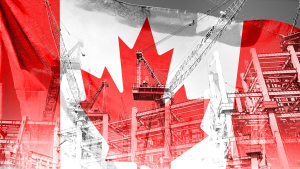Two popular books by Canadian author Pierre Berton (The Last Spike and The National Dream), a CBC television series (The National Dream) and a best-selling tune by singer-songwriter Gordon Lightfoot (The Canadian Railroad Triology), among other accounts that have been written, spoken or sung, have made the history of the building of the transcontinental Canadian Pacific Railway (CPR) well known here and abroad.
It’s no wonder the CPR story has been told and retold; it’s a rollercoaster tale of national accomplishment with a feel-good happy ending. On the other hand, the construction and consolidation of what became Canadian National Railways (now Canadian National Railway, or CN for short), makes a far less exciting story.
Although it lacks drama, the account of how CN came together is an excellent introduction to many of the themes of Canadian political economy that keep recurring right up to the present day. They include the role of megaprojects in the economy and the presence of government in those projects; the role of foreign investment in developing the economy; the boom-and-bust nature of Canadian economic development; and the Canadian genius for turning economic lemons into lemonade.
Today CN calls itself "North America’s Railroad," employing more than 22,000 people and operating almost 20,000 miles of track in Canada and the U.S., from Atlantic to Pacific and the Gulf of Mexico. In 2016, it earned revenues of C$12 billion.
Its beginnings, however, were more humble.
CN’s rival, the CPR, formed a steel ribbon that tied Canada together from east to west when it was completed in 1885.
 One of the CNR’s famous posters used to encourage travel and immigration across Canada using its railway network. – Photo:LIBRARY AND ARCHIVES CANADA
One of the CNR’s famous posters used to encourage travel and immigration across Canada using its railway network. – Photo:LIBRARY AND ARCHIVES CANADAThe country grew quickly, and by the 1890s increased immigration from Britain, Europe and the United States and growing agricultural production in the Canadian West led to the developmental of several new railways.
All of these lines were financed by heavy borrowing, mostly from British banks, and guaranteed by the individual railways.
When the First World War (1914-18) intervened, the railways’ credit dried up and they were left holding the financial bag, unable to pay back the debt they had contracted.
The railways’ problems demanded a solution, not only for themselves but also for the country as a whole.
Railways were the main medium for transporting goods and people until trucks and automobiles, as well as all-weather roads paid for by the government, became more common. As a result, railways attracted a good deal of public and political attention.
"They captured the imagination of the public the way an Olympic bid does today," said Ken Cruikshank, Dean of Humanities and Professor of History at McMaster University.
"They were seen as having the potential to be transformative game-changers, like a present-day resource megaproject."
In addition to railways’ importance to the Canadian economy, such geopolitical events as the Bolshevik Revolution in Russia in 1917 and general strikes in Winnipeg and Seattle and a police strike in Boston in 1919 were making governments — and voters — very antsy.
To look for a solution, and also to buy it some time, the federal government called a royal commission.
In 1917, it recommended nationalizing the railways (but not the CPR) and absorbing their debts.
Between 1917 and 1923 five railways were amalgamated and became Canadian National Railways: The Grand Trunk and its subsidiary, the Grand Trunk Pacific; the Intercolonial; the Canadian Northern; and the National Transcontinental.
Within the next 10 to 15 years, CN added a number of services, some of which are still with us today that were complimentary to its railway network. They include a telegraph company, which later become a CN-CPR joint venture telecommunications company; CN Radio, which later morphed into the Canadian Broadcasting Corporation (CBC); Canadian National Hotels, a chain of resort hotels across the country; and Canadian National Steamships.
Cruikshank says the burst of railway construction before the First World War was not unexpected.
"Railways compete for territory and they’re often anxious to tap into new areas," he said. "In addition, the governments of the day wanted to open up new regions of the country, especially northern Canada and the west. They also wanted to create some competition for the CPR and bring down freight rates."
There were frenzies of rail construction in other countries, too, including the US.
"There was so much overbuilding of railways in the States that there was serious talk in the 1920s of consolidation of some lines," Cruikshank said.
Although alternatives to the nationalization of the bankrupt Canadian railways, such as consolidation, were discussed, there were no viable private-sector solutions.
"Plus, at this time nationalization doesn’t have a bad name," Cruikshank said. "Ontario Hydro — the equivalent of a present-day provincial Crown corporation — is a successful business model. And in the west there were phone companies owned and run by provincial governments."
 Another one of CNR’s posters. – Photo:LIBRARY AND ARCHIVES CANADA
Another one of CNR’s posters. – Photo:LIBRARY AND ARCHIVES CANADAThe creation of CN also illustrates the important role of federal and regional politics in the development of large projects that are supposed to benefit many people.
"Prime Minister Wilfred Laurier wanted a transcontinental railway that the Liberals could claim as their own," said Graham Taylor, Professor of History emeritus at Trent University.
"The Conservative government had built the CPR and Laurier thought the Liberals should have a railway, too."
Governments and voters were angry at the CPR. Because it followed a southerly route through the prairies and British Columbia, it didn’t serve many of the more northerly settled areas in the West, such as Saskatoon and Edmonton. And the CPR seemed disinclined to build spur lines to link up with them.
Taylor says both CN and CPR were important forces in the development of the Canadian economy.
"For example, because railways are operations with high capital costs, they promoted the development of other industries to supply them, such as the manufacture of steel and machine tools," Taylor said.
"CN and CPR also enabled the establishment of national markets for such important industries as food processing, because they provided economies of scale in production and distribution."










Recent Comments
comments for this post are closed